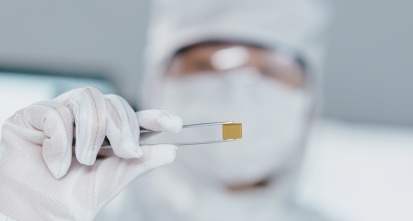Gain new perspectives for faster progress directly to your inbox.
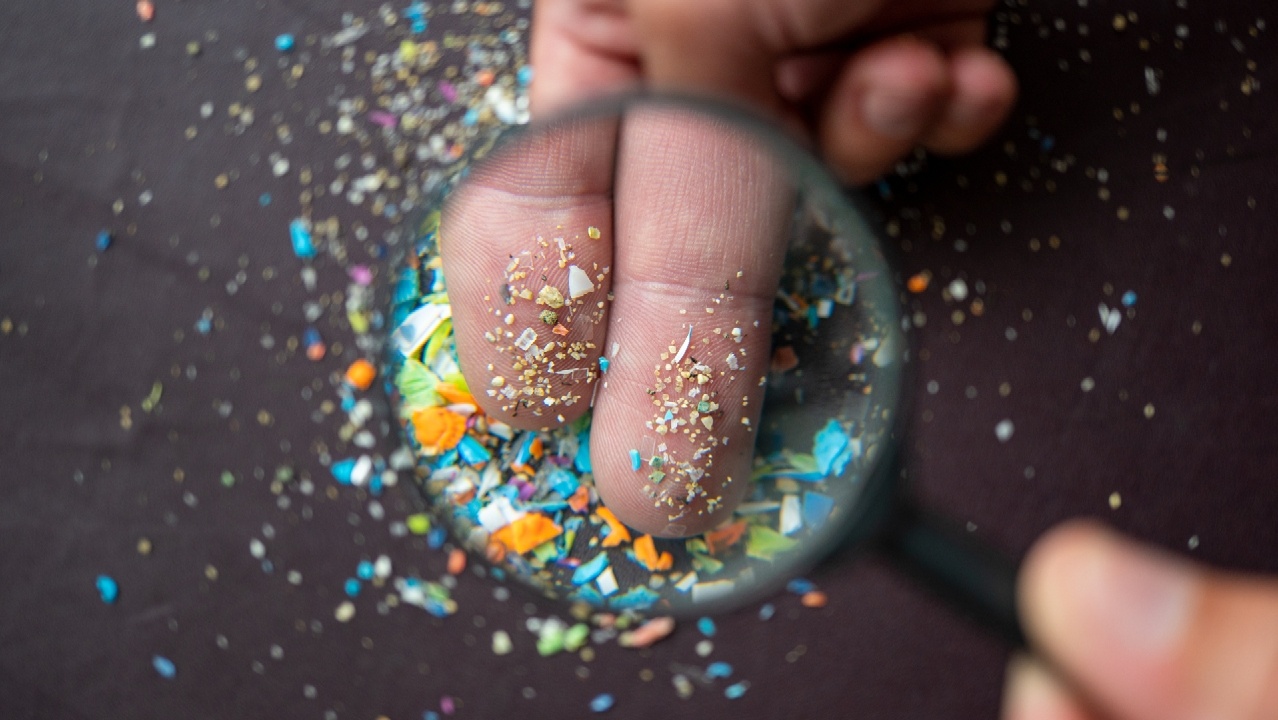
From shower to sea: waking up to the dangers of microplastics
Plastic pollution has become a substantial global problem, and one that is causing irreversible environmental damage. Microplastic particles (or microplastics), pieces of plastic measuring between 1 μm and 5 mm, are emerging contaminants that are generating intense concern. A 2022 World Health Organization (WHO) report on microplastic exposure highlights the ubiquitous nature of microplastics, which have been documented in our seas, air, soil, and food and drink.
Microplastics can be generated from primary or secondary sources. Primary microplastics are less than 5 mm in size, and sources include microbeads from cosmetics and cleaning agents, and microfibers from synthetic textiles. Secondary microplastics are formed from the breakdown of larger plastic particles and are more heterogeneous with regards to their size and composition. Examples of secondary microplastics include debris from vehicle tires, particles released from paint, road markings, marine coatings, and microfibers.
Assessing the sources, creation, and fate of microplastics is important to understand why they are so common in the environment (Figure 1). By considering a lifecycle approach to plastic, it allows the identification of key hotspots for both the production and consumption system, which takes into account the potential impact, caused by plastic products at each stage, on:
- Climate
- Ecosystems
- Health
- Economy
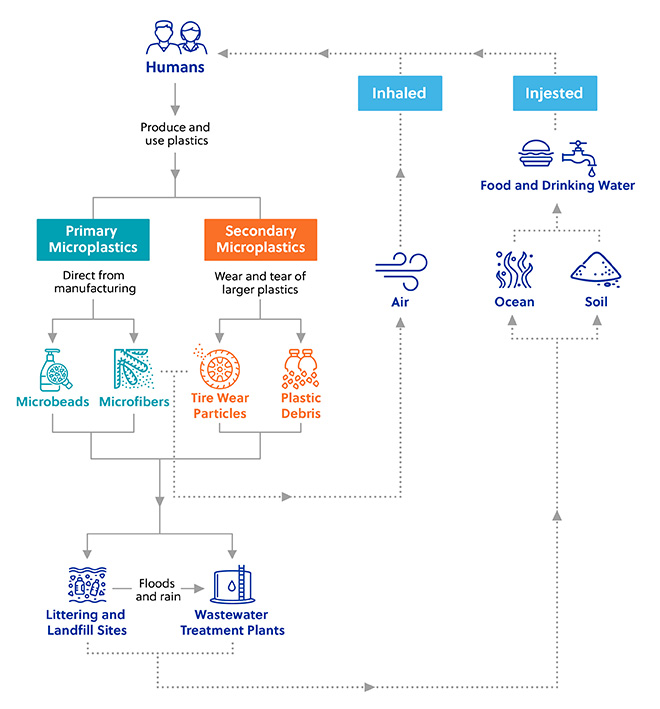
Microplastics can be taken in by organisms via ingestion, inhalation, or skin exposure. Microplastics and their associated chemicals and additives are thought to exert numerous negative effects on our health in areas such as chronic inflammatory diseases and cancer. Evidence on the effect of microplastics on marine life ranges from reduced feeding and photosynthesis to reduced reproduction. Microplastics can even carry toxic compounds and metals, which may cause further harm.
The alarm is finally sounding. It’s time for us to wake up to the threats associated with microplastics. Is enough being done to tackle this seemingly insurmountable problem?
Publication trends of microplastics
An analysis of data from the CAS Content Collection™ relating to microplastics, microfibers, and associated topics resulted in a final pool of almost 9,500 articles. Key trends in publications showed a more than 30-fold increase in microplastics publications in the ten-year period from 2011 (n=81) to 2021 (n=2,811), while the number of patents has remained stable during the same period (Figure 2).
CAS data reveals that the countries leading the way in publishing literature linked to microplastics are China, followed by the US, Germany, South Korea, and Italy (Figure 3).
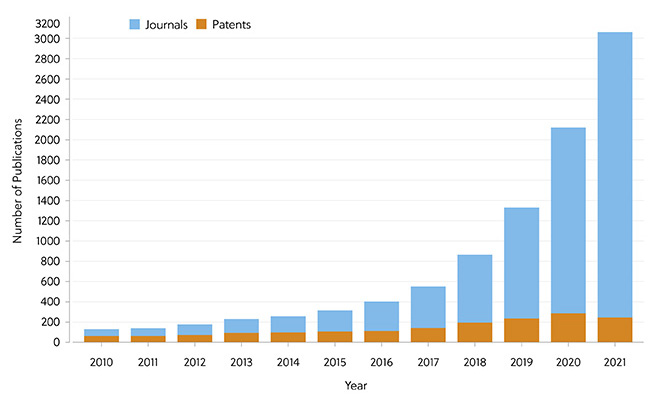
The top five substances registered in microplastic research were shown to be ethene homopolymer (polyethylene), polystyrene, 1-propene homopolymer (polypropylene), polyethylene terephthalate (PET), and polyvinyl chloride (PVC; Figure 4). Cellulose was another prominent substance featured in the findings – paradoxically, owing to its use as a polymer replacement (in applications such as electronics, biomedicine, and microplastic removal), and its presence in cellophane and rayon fibers as a microplastic — in the form of regenerated cellulose.
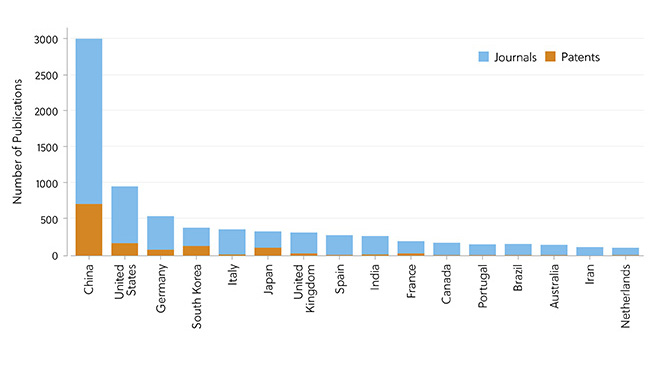
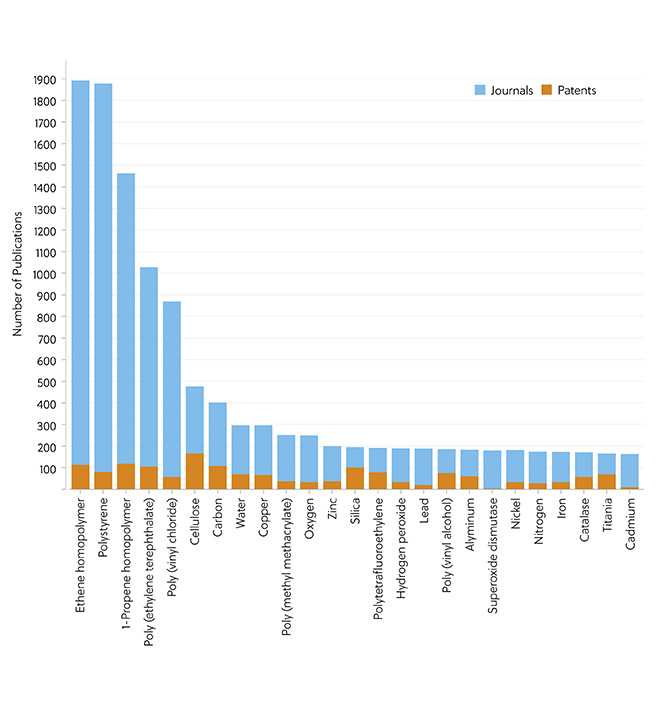
Rising to the microplastics challenge
The question that remains is this: what can be done to combat microplastics in the natural environment? Methods proposed specifically for microplastic removal from marine environments include the exploitation of ship systems, waste collecting systems, and even mussels, whose feces, owing to the plastic component, float on the water's surface. However, water collection methods can be difficult and efforts to directly remove existing microplastics in this way have been limited.
Feasible approaches to stop microplastics from entering the environment include the use of wastewater treatment plants, laundry accessories in washing machines to capture microfibers, and altering clothes manufacturing processes to minimize friction or to improve the mechanical integrity of garments.
Popular keywords relating to microplastic removal in the CAS publications analysis included ‘filtration’, ‘wastewater plants (WWTP)’, and ‘membrane bioreactor (MBR)’ (Figure 5). Publication volumes featuring most of the keywords grew significantly since the mid-2010s, suggesting that there was an immediate reaction to the problem, and removal-related research efforts appeared to increase at a pace similar to microplastic research in general.
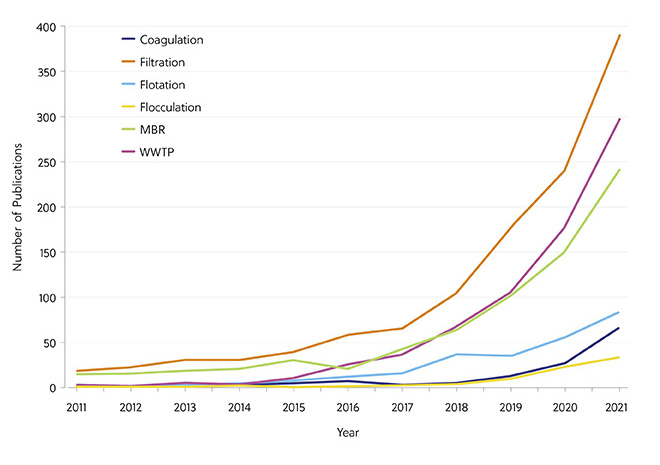
MBR, membrane bioreactor; WWTP, wastewater treatment plant
What is perhaps most important is that we mitigate our plastic use in general. Biodegradable or sustainable alternatives, such as shampoo bars and bamboo sponges, along with zero-waste shops and ethical fashion brands, are all growing in popularity.
The combat against microplastic pollution will require long-term dedication and concerted efforts among scientists, researchers, entrepreneurs, governments, and the public. Barriers to microplastic removal efforts include shortcomings with existing data according to the WHO, where the quality of evidence is not considered robust.
More field and laboratory research must be undertaken to characterize the true effects of microplastics on health, including their retainment in and elimination from tissues, along with their binding activity. Refining analytical tools that can detect smaller particles (nanoplastics) is another top priority.
While experts recognize the myriad ways in which we can tackle the microplastics problem, funding for microplastic removal, and the lack of associated profitability, presents a key challenge. Financial assistance and ramping up regulatory laws on plastic use will help accelerate progress toward a more sustainable plastics economy, and a cleaner, healthier future. Read more on this topic in our Microplastics Insight Report.

